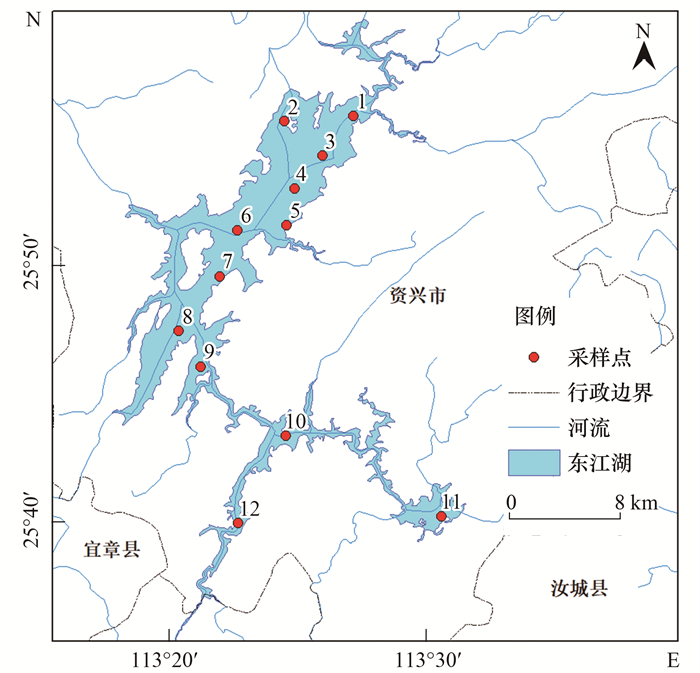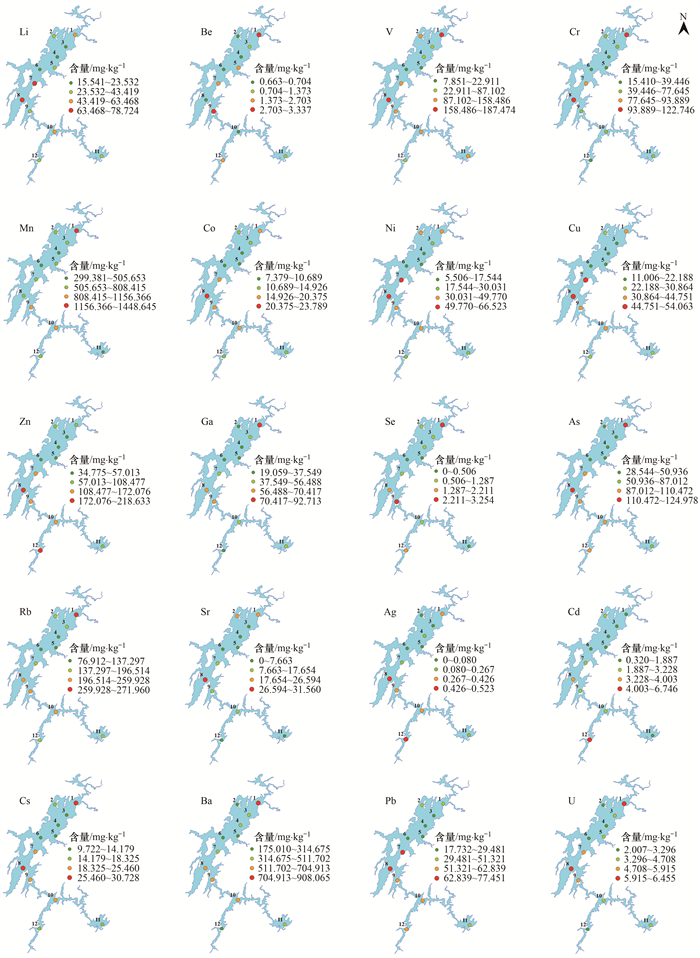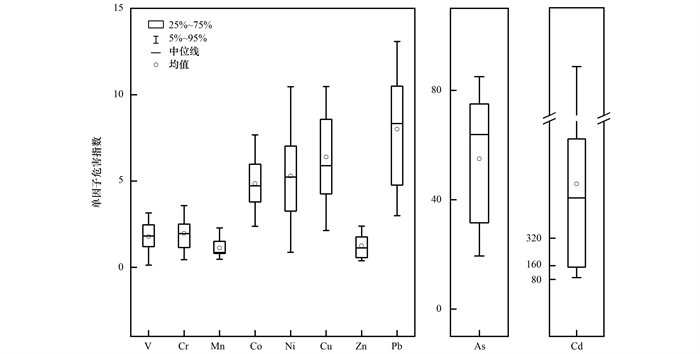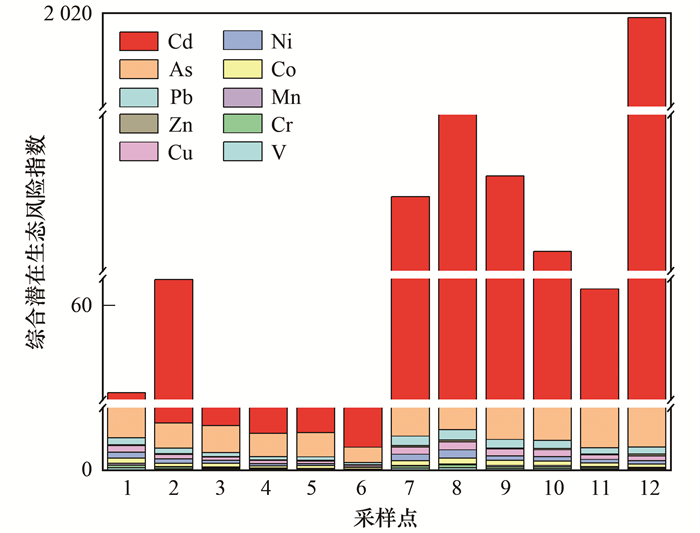2. 中国环境科学研究院, 国家环境保护湖泊污染控制重点实验室, 湖泊水污染治理与生态修复技术国家工程实验室, 国家环境保护洞庭湖科学观测研究站, 北京 100012;
3. 北京师范大学水科学研究院, 北京 100875;
4. 沧州师范学院生命科学学院, 沧州 061001
2. State Environmental Protection Key Laboratory for Lake Pollution Control, National Engineering Laboratory for Lake Pollution Control and Ecological Restoration, State Environmental Protection Scientific Observation and Research Station for Lake Dongting, Chinese Research Academy of Environmental Sciences, Beijing 100012, China;
3. College of Water Science, Beijing Normal University, Beijing 100875, China;
4. College of Life Science, Cangzhou Normal University, Cangzhou 061001, China
湖泊能够存储气候变化和人类活动信息, 具有蓄水防洪和调节气候等生态服务功能, 在维护区域生态与环境安全方面具有特殊地位[1].随着湖泊流域内人类活动的日益频繁, 湖泊水生态环境安全堪忧, 湖泊富营养化, 蓝藻水华灾害和重金属污染等问题频繁发生[2].重金属通过干湿沉降和雨水径流等路径排入湖泊后, 累积在沉积物中[3].当重金属含量达到一定阈值时, 会降低植物根系对营养物质的吸收等能力, 导致植物营养不良甚至大量死亡, 还会造成动物和人类产生神经毒性及心血管损伤等健康风险[4].重金属污染危害大、影响范围广, 严重影响了湖泊流域内居民的健康与生存质量[5].
东江湖是我国位于湖南省东南部的一个大型水电工程[6], 其两岸群山环抱, 区内平均海拔700~800 m, 最高点为桂东八面山(海拔2042 m), 最低点为资兴东江大坝码头(海拔290 m), 盆地整体地形呈东北>东南>西南>西北的趋势.自1986年作为水库蓄水以来, 东江湖充分发挥了湖南省重要饮用水源的作用[7].目前有关东江湖水质问题的研究主要集中在水环境承载力[8]和水文特征[9]等方面, 关于重金属污染特征及潜在风险方面鲜见报道.
本研究在东江湖设置了12个采样点, 测定了: 锂(Li)、铍(Be)、钒(V)、铬(Cr)、锰(Mn)、钴(Co)、镍(Ni)、铜(Cu)、锌(Zn)、镓(Ga)、砷(As)、硒(Se)、铷(Rb)、锶(Sr)、银(Ag)、镉(Cd)、铯(Cs)、钡(Ba)、铅(Pb)和铀(U)共20种重金属的浓度, 分析了东江湖沉积物中重金属的浓度水平和空间分布特征, 并进行潜在生态风险评估和来源解析, 以期为东江湖及同类型湖泊水环境保护研究提供科学依据和必要数据支持.
1 材料与方法 1.1 研究区概况研究区控制流域面积4 719 km2, 占湘江一级支流耒水流域面积39.6%, 主要支流有浙水、滁水和淇水等[10].流域内矿产资源丰富且分布广泛, 已探明的矿种有煤、钨、铅、硅石和石灰石等30余种[11], 钨矿和铁矿主要分布在汝城县; 锡矿主要分布在桂东县; 煤矿主要分布在汝城文明、外沙、土桥和桂东沙田等地.同时, 流域重点工业企业主要集中在汝城县和桂东县, 涉及稀土金属矿采选业、非金属矿物制品业、有色金属合金制造业和无机盐制造业等, 其中稀土金属矿采选业为流域主要工业, 占整个流域工业行业的52.1%.由于人为流域开发等历史遗留原因, 东江湖部分地区的水环境, 特别是水库尾水已经遭到破坏, 上游有色金属矿山遗留的大量尾矿、废石和废渣没有得到妥善处理, 随着生态破坏和水土流失, 其中的重金属随径流不断汇入湖中, 东江湖水环境面临较大的风险[10, 12].
1.2 仪器与试剂电感耦合等离子体质谱仪(ICP-MS, Agilent-7700x, 美国); 硝酸和盐酸(AR级, 上海国药集团, 中国)等.
1.3 样品采集与测试2021年2月, 依据东江湖现有水域面积和地形条件, 在库区共布置采样点12个, 具体采样点位分布如图 1所示.使用抓泥斗采集水库沉积物1~5 cm表层样品, 并用自封袋密封寄回实验室, -35℃保存待测.

|
图 1 东江湖表层沉积物采样点位示意 Fig. 1 Sampling sites of Dongjiang Lake |
沉积物样品经过冷冻干燥后去除杂质, 研磨并过100目筛备用: ①称取待测样品0.1 g置于聚四氟乙烯密闭消解罐中, 加入6 mL王水(盐酸∶硝酸=3 ∶1)准备消解; ②待样品完全消解后冷却至室温, 取用慢速定量滤纸过滤提取液, 收集于50 mL容量瓶中; ③用少量硝酸溶液清洗消解罐的盖子内壁、罐体内壁和滤渣至少3次, 并将洗液一并过滤收集于容量瓶中, 用实验用水定容至刻度; ④用ICP-MS进行重金属的测定.
1.4 质量保证与控制本实验全程避免接触金属物品, 所有试剂均为优级纯, 试剂溶液均用二次去离子水配制, 实验前后将消解罐在酸缸中浸泡24 h.采用程序空白和国家标准土壤样品(GBW07366 GSD-2)作为质量控制样品, 结果显示各元素回收率在91% ~105%之间; 所有样品均做3次平行样, 最后的结果以3次测试分析的平均值显示, 3次分析结果的误差范围 < 10%; 同时每10个样品做1次分析空白.
1.5 地累积指数法地累积污染指数法是研究重金属污染程度的定量指标, 主要考虑重金属污染的人为因素、环境的地球化学背景值和自然成岩引起背景值变化的因素[13].其计算公式如下:

|
(1) |
式中, Ci为第i种重金属的含量(mg ·kg-1); Bi为被测元素的环境背景值(mg ·kg-1), 本研究采用湖南省土壤各元素背景值的算术平均值[14]作为参考值(表 3), K为考虑成岩作用引起环境背景值变动而取的系数, 一般为1.5, 根据地累积指数Igeo计算结果可将重金属污染程度划分等级, 如表 1所示.
|
|
表 1 重金属污染级别 Table 1 Heavy metal contamination levels |
1.6 潜在风险指数法
潜在生态风险指数法[15]是常用的评估水体沉积物重金属风险的方法, 综合考虑重金属毒性水平、环境背景值和多种重金属的协同作用, 通过设定毒性响应系数对重金属进行综合评估, 其表达式如下:

|
(2) |
式中, RI为多因子综合潜在生态风险指数; Eri为单因子危害指数; Tri为毒性响应系数, 反映重金属的毒性水平及生物对重金属污染的敏感程度.通过已有研究并结合本文测得重金属含量, 得出了V、Mn、Co、Ni、Cr、Cu、Zn、Cd、Pb和As共10种元素的毒性响应系数, 分别为2、1、5、5、2、5、1、30、5和10[16, 17]. Ci为第i种重金属的实测浓度(mg ·kg-1); Cni为被测元素的环境背景值, 本研究采用湖南省土壤各元素背景值[14]的算术平均值作为参考值.根据RI和Eri值的大小, 潜在生态风险指数划分标准见表 2.
|
|
表 2 潜在生态风险评估指标与等级划分 Table 2 Potential ecological risk assessment indicators and classification |
2 结果与讨论 2.1 表层沉积物重金属检出情况
东江湖表层沉积物重金属检出含量统计见表 3.本研究共检测出20种金属元素, 除Li、Be、V、Cr、Co、Sr和U外, 其余元素的含量平均值均超过背景值, 其中Cd、As和Se的含量平均值分别是背景值[14]的21.2、5.5和4.1倍.所有采样点中Cd、As和Ga均超过背景值, 66.7%采样点中Zn、Cu、Pb和Ag含量超出背景值.综合来看, 东江湖Cd和As超标严重, 这与已有研究的结果较为一致[10].依据文献[18]中的风险筛选值与风险管制值, Cr、Ni、Cu、Zn和Pb的含量平均值低于风险筛选值, As和Cd的含量平均值高于风险筛选值, 低于风险管制值, 可能存在沉积物污染风险.所有采样点中As含量均超过风险筛选值, 8.33%采样点的As含量超过风险管控值, 58.3%采样点的Cd含量超过风险筛选值.
|
|
表 3 表层沉积物中重金属含量的描述性统计1) Table 3 Descriptive statistics on the content of heavy metals in surface sediments |
变异系数反映了沉积物重金属区域分布的变异程度, 变异系数越大, 表明人类活动对重金属区域分布影响越高.由表 3可知, Sr的变异系数为1.14, 属高度变异, V、Zn、Be、Ag、Se、Sr和Cd的变异系数大于0.5, 其余重金属的变异系数范围为0.31~0.5, 属中等程度变异.
将东江湖表层沉积物重金属含量与省内洞庭湖[19]的重金属含量进行比较, 明显可以看出, Cr、Cu、Cd和Pb的含量平均值低于洞庭湖, As的含量高于洞庭湖, 这可能与湖泊的地质背景差异和人为活动因素有关.与湘江长沙段[20]沉积物重金属进行比较, 东江湖的重金属含量均处于较低水平, 这可能是因为重金属不断迁移和累积富集在下游湘江长沙段所致.与国内外其他湖泊沉积物重金属含量进行比较可以看出(表 4), 东江湖沉积物重金属中As和Cd含量明显高于其他湖泊, Cr和Ni含量与洪泽湖含量相当, Cu和Pb含量在这些湖泊沉积物中处于平均水平, V、Mn和Co含量处于较低水平.
|
|
表 4 国内外不同湖泊/水库沉积物重金属含量1)/mg ·kg-1 Table 4 Heavy metal concentrations of sediments in different lakes/reservoirs at home and abroad/mg ·kg-1 |
2.2 表层沉积物重金属空间分布特征
东江湖沉积物重金属含量的空间分布见图 2.其中Li、Ni、Cu和Pb在空间分布上呈现规律较为一致, 高浓度区域为湖体中部; Be、V、Cr、As、Se、Cs和U高浓度区域均呈现于东北方向和湖体中部; Zn和Ag的最高值均出现在湖体中部和西南方向; Mn、Ga、Rb和Ba的最高值出现在东北方向; Co和Sr的最高值出现在湖体中部; Cd的最高值出现在西南方向.从全湖水平来看, 湖区南部的7、8、9、10和12号点位重金属含量值最高, 其次是北部的1号和2号点位, 湖区中部和东南方向11号点位重金属含量相对较低.

|
图 2 东江湖沉积物重金属含量空间分布特征 Fig. 2 Spatial distribution characteristics of heavy metal concentrations in sediments in Dongjiang Lake |
地累积指数统计结果见图 3和表 5, 东江湖表层沉积物中各重金属的污染程度顺序为: Cd>As>Se>Ga>Ag>Pb>Rb>Cs>Cu>Ba>Zn>Mn>Co>Ni>Cr>Li>U>V>Be>Sr.其中Cd的污染程度最高, Igeo平均值为3.2, 整体来看平均污染等级为偏重度, 其中北部Cd污染情况相对较轻. As的Igeo平均值为1.7, 污染等级为偏中度, 其中南部As的污染情况较重. Se的Igeo平均值为1.1, 全湖平均污染等级达到偏中度污染, 北部和南部的污染情况较重, 中部较轻.Ga的Igeo平均值为0.5, 全湖平均污染等级为轻度污染. Ag的Igeo平均值为0.3, 整体呈现为轻度污染, 南部的污染情况较重.其余元素的Igeo平均值小于0, 无污染情况. Pb在湖库南部略有污染.U在所有采样点均为无污染.

|
图 3 东江湖表层沉积物重金属地质累积指数箱线图 Fig. 3 Box chart of heavy metal geological accumulation index of surface sediments of Dongjiang Lake |
|
|
表 5 地质累积指数法和潜在生态风险评估结果1) Table 5 Geological accumulation index method and potential ecological risk assessment results |
东江湖沉积物中Cd元素与嘉陵江亭子口水库[30]沉积物中Cd元素的Igeo平均值(3.68)水平接近, 远高于洞庭湖(2020年)[31]沉积物中Cd的Igeo平均值(0.41). As与沙河水库沉积物[24]中As的Igeo值(1.73)水平相当.
2.3.2 潜在生态风险指数法评价在众多用潜在生态危害指数法评价重金属污染的文献中, 结合本研究测得重金属含量, 找出了V、Mn、Co、Ni、Cr、Cu、Zn、Cd、Pb和As共10种元素的毒性响应系数, 根据公式计算所得重金属的Eri值和RI值结果见图 4、图 5和表 5.东江湖表层沉积物中10种重金属的Eri平均值顺序为: Cd>As>Pb>Cu>Ni>Co>Cr>V>Zn>Mn(与鄱阳湖[32]Cu和Pb排序相反, 其余保持一致), Cd的Eri平均值为635, 单项潜在生态风险指数为极高; As的Eri值为19~85, Eri平均值为55, 单项潜在生态风险指数为中等; 将东江湖整体大致分为北部、中部和南部, 从全湖水平上看, Cd和As在湖库南部的潜在风险最高.其余重金属的潜在生态风险程度均表现为低风险.

|
图 4 东江湖表层沉积物重金属单项潜在生态风险指数箱线图 Fig. 4 Single potential ecological risk index box chart of heavy metals in the surface sediments of Dongjiang Lake |

|
图 5 东江湖各采样点综合生态风险指数 Fig. 5 Integrated ecological risk index for each sampling point of Dongjiang Lake |
RI值的范围为138~2 014, 平均值为721, 西南方向12号采样点综合生态风险等级最高, 这说明东江湖部分区域沉积物的重金属污染对生态系统存在潜在风险, 需采取相关措施来减缓重金属污染.从各重金属对综合潜在生态风险的平均贡献来看, Cd是最主要的生态风险贡献因子, 对综合潜在生态风险指数的贡献率达到88.1%, 可以看出, 东江湖表层沉积物中Cd含量虽然较低, 但潜在生态风险程度却最高, 表明受到一定程度的污染, 应引起有关部门的重视.
2.4 表层沉积物重金属的相关性及源解析本研究结合东江湖主要重金属污染水平、毒性系数和重金属研究的广泛性等因素, 重点选择沉积物中Cr、Cu、Zn、Ga、As、Se、Ag、Cd、Ba和Pb共10种重金属元素进行相关性分析和源解析.
相关性分析结果若显示金属元素之间相关性显著, 说明它们可能具有相同来源[33].由表 6可知, Cr与Cu、Ga和Pb之间显著相关, 其中Cu与Pb之间极显著相关, 但值得注意的是Cu与Ga之间并不存在显著正相关, 且Cu与Se、Ag和Cd之间存在显著相关, Ga与As和Ba之间存在显著相关, 这说明可能部分Cr与Cu和Pb具有相同来源, 部分Cr与部分Ga具有相同来源, 其余重金属均具有相似特征, 说明在东江湖沉积物重金属之间可能产生了复合污染, 有潜在的相似来源和迁移途径.
|
|
表 6 沉积物中重金属含量的皮尔逊相关系数矩阵1) Table 6 Pearson correlation coefficient matrix of heavy metal content in sediments |
为进一步了解东江湖沉积物重金属的污染来源, 采用因子分析对其进行源解析.KMO值(0.613>0.6)和Bartletts球形检验(0.00 < 0.05)结果表明采用主成分分析是有效的[34, 35].结果如表 7所示, 主成分1和主成分2特征值分别为7.203和1.900, 对应方差贡献率为72.027%和18.998%, 累计方差贡献率为91.025%, 能反映所有数据的绝大部分信息.
|
|
表 7 东江湖沉积物重金属主成分分析 Table 7 Analysis of the main components of heavy metals in sediments in Dongjiang Lake |
主成分1中Cr、Cu、Zn、Ga、As、Se、Ag、Ba和Pb均具有较高载荷, 其中Cr元素含量趋于近湖南省背景值, 且生态风险较低、变异系数较小, 因此可以推测Cr主要受自然背景影响, 符合自然输入的规律, 为自然源金属.有研究表明As、Pb、Zn和Cu的来源主要是采矿冶炼和金属加工等工业活动[36, 37], 流域内郴州柿竹园矿区是我国最大的有色金属矿床, 主要伴生矿种包括: As、Cd、Cu、Ga和Ag等[38], Ga主要存在于闪锌矿中[39], Se以黏土矿物吸附形式存在, Ba污染主要以硫酸钡和碳酸钡的状态存在[40].流域内的矿石冶炼等工业活动所排放废气、废水和固废渗漏中的重金属会通过大气沉降、地表径流和地下渗流等途径进入湖泊[41], 在一定程度上增加东江湖沉积物重金属含量.还有研究表明As元素主要来源于废水灌溉、施用化肥和农药等方面[42], 东江湖流域农田面积约为695.3 km2[43], 农田及周边土壤中的重金属会随着降水径流进入东江湖, 因此部分As还可能来源于农业生产.除采矿冶炼外, 部分Pb污染的另一个重要来源是煤与汽油等燃料的燃烧, 最后通过大气沉降进入湖泊, 在沉积物中不断累积[44].主成分2仅表征了Cd元素, 且Cd在主成分1和主成分2均表现出较高载荷, 可以认为湖泊中的Cd与流域上游矿石冶炼等工业活动带入有关.此外, 东江湖还是湖南省重要的渔业生产基地, 研究表明水产饲料中的鱼粉也含有一定含量的Cd元素[22, 45], 因此Cd还可能受到渔业饲料投放的影响.
综上所述, 可认为东江湖沉积物重金属主要受到生活生产污水、工农业废水排放和采矿冶炼工业等人类活动的影响, 部分元素由自然源产生.
3 结论(1) 东江湖表层沉积物中有20种重金属检出, 其中除Li、Be、V、Cr、Co、Sr和U外, 其余重金属的含量平均值均超过了湖南省土壤背景值; 空间整体呈现为库区南部>库区北部>库区中部的特征, Li、Ni、Cr、Co、Cs、Cu、Sr、Rb、U、V、Ba和As的空间分布相似, 其他重金属元素均在不同局部出现污染水平较高的情况.
(2) 地累积指数法评价显示东江湖表层沉积物中Cd为偏重度污染, As和Se表现为偏中度污染水平, Ag和Ga为轻度污染, 其他重金属无污染.潜在生态风险指数评价表明东江湖表层沉积物整体表现为高风险水平, 主要环境风险因子是Cd, 表现为极高风险; 其次是As, 表现为中等风险; 其他重金属的生态风险较低, 总体情况良好.
(3) 利用相关性分析和主成分分析表明, 东江湖表层沉积物重金属主要受到生活生产污水、工农业废水排放和采矿冶炼工业等人类活动的影响.
| [1] | Chen H Y, Jing L J, Yao Z P, et al. Prevalence, source and risk of antibiotic resistance genes in the sediments of Lake Tai (China) deciphered by metagenomic assembly: a comparison with other global lakes[J]. Environment International, 2019, 127: 267-275. DOI:10.1016/j.envint.2019.03.048 |
| [2] |
高煜, 王国兰, 金梓函, 等. 千河下游水体-沉积物重金属空间分布、风险及影响因素[J]. 环境科学, 2021, 42(11): 5333-5345. Gao Y, Wang G L, Jin Z H, et al. Spatial distribution, risk, and influencing factors of river water-sediment heavy metals in the lower reaches of the Qianhe River[J]. Environmental Science, 2021, 42(11): 5333-5345. |
| [3] |
李贝, 道金荣, 朱润云, 等. 滇池重金属污染的分布、积累和风险评估[J]. 环境化学, 2021, 40(6): 1808-1818. Li B, Dao J R, Zhu R Y, et al. Distribution, accumulation and risk assessment of heavy metal pollution in Dianchi Lake[J]. Environmental Chemistry, 2021, 40(6): 1808-1818. |
| [4] |
李悦昭, 陈海洋, 孙文超. "河-湖"沉积物重金属环境特征及来源解析[J]. 环境科学, 2020, 41(6): 2646-2652. Li Y Z, Chen H Y, Sun W C. Environmental characteristics and source apportionment of heavy metals in the sediments of a River-Lake System[J]. Environmental Science, 2020, 41(6): 2646-2652. |
| [5] |
江涛, 林伟稳, 曹英杰, 等. 梅江流域清凉山水库沉积物重金属污染、生态风险评价及来源解析[J]. 环境科学, 2020, 41(12): 5410-5418. Jiang T, Lin W W, Cao Y J, et al. Pollution and ecological risk assessment and source apportionment of heavy metals in sediments of Qingliangshan reservoir in the Meijiang basin[J]. Environmental Science, 2020, 41(12): 5410-5418. |
| [6] |
邹忠义, 姚德华, 孙立仲, 等. 东江水库碳汇渔业与生态保护的初步研究[J]. 水生态学杂志, 2011, 32(4): 79-84. Zou Z Y, Yao D H, Sun L Z, et al. Preliminary studies on carbon sinking fisheries and ecological protection in Dongjiang reservoir[J]. Journal of Hydroecology, 2011, 32(4): 79-84. |
| [7] |
何望. 东江湖水环境及渔业可持续发展研究[D]. 长沙: 湖南农业大学, 2012. He W. Study on waters environment and sustainable fisheries development in Dongjiang Lake[D]. Changsha: Hunan Agricultural University, 2012. |
| [8] |
马巾英. 东江湖库区水环境承载力评价及协调发展研究[J]. 经济地理, 2015, 35(11): 184-189. Ma J Y. Dongjiang Lake reservoir area' evaluation of water environmental carrying capacity and the research of the coordinated development[J]. Economic Geography, 2015, 35(11): 184-189. |
| [9] |
黄速艇, 陈森林, 艾学山, 等. 基于流量分级的生态流量过程线确定方法——以东江水库为例[J]. 水资源与水工程学报, 2014, 25(5): 22-27. Huang S T, Chen S L, Ai X S, et al. Deterministic method of ecological flow process line based on flow classification: a case study in Dongjiang reservoir[J]. Journal of Water Resources and Water Engineering, 2014, 25(5): 22-27. |
| [10] | 王圣瑞. 东江湖水环境[M]. 北京: 科学出版社, 2018. |
| [11] |
徐源, 师华定, 王超, 等. 湖南省郴州市苏仙区重点污染企业影响区的土壤重金属污染源解析[J]. 环境科学研究, 2021, 34(5): 1213-1222. Xu Y, Shi H D, Wang C, et al. Heavy metal pollution sources in soil affected by key pollution enterprises in Suxian District, Chenzhou City, Hunan province[J]. Research of Environmental Sciences, 2021, 34(5): 1213-1222. |
| [12] |
付广义, 邱亚群, 宋博宇, 等. 东江湖铅锌矿渣堆场优势植物重金属富集特征[J]. 中南林业科技大学学报, 2019, 39(4): 117-122. Fu G Y, Qiu Y Q, Song B Y, et al. Heavy metals enrichment characteristics of the dominant plants in lead-zinc slag yard along Dongjiang lake reservoir[J]. Journal of Central South University of Forestry & Technology, 2019, 39(4): 117-122. |
| [13] | Müller G. Index of geoaccumulation in sediments of the Rhine River[J]. Geojournal, 1969, 2(3): 108-118. |
| [14] | 国家环境保护局, 中国环境监测总站. 中国土壤元素背景值[M]. 北京: 中国环境科学出版社, 1990. |
| [15] | Hakanson L. An ecological risk index for aquatic pollution control.a sedimentological approach[J]. Water Research, 1980, 14(8): 975-1001. DOI:10.1016/0043-1354(80)90143-8 |
| [16] |
张晶晶, 马传明, 匡恒, 等. 青岛市土壤重金属污染的物元可拓评价[J]. 中国环境科学, 2017, 37(2): 661-668. Zhang J J, Ma C M, Kuang H, et al. Assessment of heavy metals pollution in soil of Qingdao based on matter-element extension model[J]. China Environmental Science, 2017, 37(2): 661-668. |
| [17] |
胡梦珺, 李春艳, 李娜娜, 等. 基于物元可拓模型的兰州市主城区公园表土重金属污染评价[J]. 环境科学, 2021, 42(5): 2457-2468. Hu M J, Li C Y, Li N N, et al. Using the matter-element extension model to assess heavy metal pollution in topsoil in parks in the main district park of Lanzhou City[J]. Environmental Science, 2021, 42(5): 2457-2468. |
| [18] | GB 15618-2018, 土壤环境质量农用地土壤污染风险管控标准(试行)[S]. |
| [19] |
唐聪, 钱宝, 李炜钦, 等. 洞庭湖区表层沉积物重金属污染特征与风险评价[J]. 人民长江, 2020, 51(6): 49-56, 62. Tang C, Qian B, Li W Q, et al. Pollution characteristics and risk evaluation of heavy metals in surface sediments of Dongting Lake[J]. Yangtze River, 2020, 51(6): 49-56, 62. |
| [20] |
王勤, 彭渤, 方小红, 等. 湘江长沙段沉积物重金属污染特征及其评价[J]. 环境化学, 2020, 39(4): 999-1011. Wang Q, Peng B, Fang X H, et al. Characteristics and assessment of heavy metal contamination in sediments from Changsha section of the Xiangjiang River, Hunan Province of China[J]. Environmental Chemistry, 2020, 39(4): 999-1011. |
| [21] |
张杰, 郭西亚, 曾野, 等. 太湖流域河流沉积物重金属分布及污染评估[J]. 环境科学, 2019, 40(5): 2202-2210. Zhang J, Guo X Y, Zeng Y, et al. Spatial distribution and pollution assessment of heavy metals in river sediments from Lake Taihu Basin[J]. Environmental Science, 2019, 40(5): 2202-2210. DOI:10.3969/j.issn.1000-6923.2019.05.049 |
| [22] |
訾鑫源, 张鸣, 谷孝鸿, 等. 洪泽湖围栏养殖对表层沉积物重金属含量影响与生态风险评价[J]. 环境科学, 2021, 42(11): 5355-5363. Zi X Y, Zhang M, Gu X H, et al. Impact of enclosure culture on heavy metal content in surface sediments of Hongze Lake and ecological risk assessment[J]. Environmental Science, 2021, 42(11): 5355-5363. |
| [23] | Zhu L, Liu J W, Xu S G, et al. Deposition behavior, risk assessment and source identification of heavy metals in reservoir sediments of Northeast China[J]. Ecotoxicology and Environmental Safety, 2017, 142: 454-463. DOI:10.1016/j.ecoenv.2017.04.039 |
| [24] |
杨颖, 孙文, 刘吉宝, 等. 北运河流域沙河水库沉积物重金属分布及生态风险评估[J]. 环境科学学报, 2021, 41(1): 217-227. Yang Y, Sun W, Liu J B, et al. Distribution and ecological risk assessment of heavy metals in sediments of Shahe Reservoir in Northern Canal Basin[J]. Acta Scientiae Circumstantiae, 2021, 41(1): 217-227. |
| [25] |
罗哲, 许仕荣, 卢少勇. 丹江口水库表层沉积物重金属污染特征及风险评价[J]. 湖南师范大学自然科学学报, 2021, 44(3): 1-8, 17. Luo Z, Xu S R, Lu S Y. Pollution characteristics and evaluation of heavy metals in surface sediments of Danjiangkou Reservoir[J]. Journal of Natural Science of Hunan Normal University, 2021, 44(3): 1-8, 17. |
| [26] | Bing H J, Wu Y H, Zhou J, et al. Spatial variation of heavy metal contamination in the riparian sediments after two-year flow regulation in the Three Gorges Reservoir, China[J]. Science of the Total Environment, 2019, 649: 1004-1016. DOI:10.1016/j.scitotenv.2018.08.401 |
| [27] | Lee P K, Kang M J, Yu S, et al. Enrichment and geochemical mobility of heavy metals in bottom sediment of the Hoedong reservoir, Korea and their source apportionment[J]. Chemosphere, 2017, 184: 74-85. DOI:10.1016/j.chemosphere.2017.05.124 |
| [28] | Gwimbi P, Kotelo T, Selimo M J. Heavy metal concentrations in sediments and Cyprinus carpio from Maqalika Reservoir-Maseru, Lesotho: an analysis of potential health risks to fish consumers[J]. Toxicology Reports, 2020, 7: 475-479. DOI:10.1016/j.toxrep.2020.03.005 |
| [29] | Hussein A M, Jabbar D N, Ali A R. Spatial distribution and evaluation of heavy metals in surface sediments of the Al-Najaf sea depression reservoir, Iraq[J]. Alexandria Engineering Journal, 2020, 59(6): 5197-5206. DOI:10.1016/j.aej.2020.09.049 |
| [30] |
可华明, 杨清伟, 刘守江, 等. 嘉陵江亭子口水库沉积物重金属分布特征及风险评价[J]. 安全与环境学报, 2020, 20(6): 2389-2397. Ke H M, Yang Q W, Liu S J, et al. Distribution of the heavy metal contaminants and the corresponding eco-hazard risk assessment in the sediment of Tingzikou Reservoir of Jialing River[J]. Journal of Safety and Environment, 2020, 20(6): 2389-2397. |
| [31] |
李照全, 方平, 黄博, 等. 洞庭湖区典型内湖表层沉积物中氮、磷和重金属空间分布与污染风险评价[J]. 环境科学研究, 2020, 33(6): 1409-1420. Li Z Q, Fang P, Huang B, et al. Distribution and ecological risk assessment of nitrogen, phosphorus and heavy metals in surface sediments of typical internal lakes in Dongting Lake area[J]. Research of Environmental Sciences, 2020, 33(6): 1409-1420. |
| [32] |
匡荟芬. 鄱阳湖区沉积物和土壤重金属污染特征、风险评价及源解析[D]. 南昌: 南昌大学, 2020. Kuang H F. Pollution characteristics, risk assessment and source apportionment of heavy metals in sediments and soils of Poyang Lake Area[D]. Nanchang: Nanchang University, 2020. |
| [33] |
曾维特, 杨永鹏, 张东强, 等. 海南岛北部海湾沉积物重金属来源、分布主控因素及生态风险评价[J]. 环境科学, 2018, 39(3): 1085-1094. Zeng W T, Yang Y P, Zang D Q, et al. Sources, distribution of main controlling factors, and potential ecological risk assessment for heavy metals in the surface sediment of Hainan Island north bay, South China[J]. Environmental Science, 2018, 39(3): 1085-1094. |
| [34] | Bhardwaj R, Gupta A, Garg J K. Evaluation of heavy metal contamination using environmetrics and indexing approach for River Yamuna, Delhi stretch, India[J]. Water Science, 2017, 31(1): 52-66. DOI:10.1016/j.wsj.2017.02.002 |
| [35] |
王漫漫. 太湖流域典型河流重金属风险评估及来源解析[D]. 南京: 南京大学, 2016. Wang M M. Risk assessment and source apportionment of heavy metals in typical rivers of Taihu Basin[D]. Nanjing: Nanjing University, 2016. |
| [36] |
李强, 曹莹, 何连生, 等. 典型冶炼行业场地土壤重金属空间分布特征及来源解析[J]. 环境科学, 2021, 42(12): 5930-5937. Li Q, Cao Y, He L S, et al. Spatial distribution characteristics and source analysis of soil heavy metals in typical smelting industry sites[J]. Environmental Science, 2021, 42(12): 5930-5937. |
| [37] |
张婉军, 辛存林, 于奭, 等. 柳江流域河流溶解态重金属时空分布及污染评价[J]. 环境科学, 2021, 42(9): 4234-4245. Zhang W J, Xin C L, Yu S, et al. Spatial and temporal distribution and pollution evaluation of soluble heavy metals in Liujiang River Basin[J]. Environmental Science, 2021, 42(9): 4234-4245. |
| [38] |
盛维康, 侯青叶, 杨忠芳, 等. 湘江水系沉积物重金属元素分布特征及风险评价[J]. 中国环境科学, 2019, 39(5): 2230-2240. Sheng W K, Hou Q Y, Yang Z F, et al. Distribution characteristics and ecological risk assessment of heavy metals in sediments from Xiang River[J]. China Environmental Science, 2019, 39(5): 2230-2240. DOI:10.3969/j.issn.1000-6923.2019.05.052 |
| [39] |
赵飞燕, 张小东, 郭昭华, 等. 金属镓的分布、生产及应用前景[J]. 轻金属, 2017(3): 1-3. Zhao F Y, Zhang X D, Guo Z H, et al. Distribution, production and application prospects of gallium[J]. Light Metals, 2017(3): 1-3. |
| [40] | Wang G X, Zeng C, Zhang F, et al. Traffic-related trace elements in soils along six highway segments on the Tibetan Plateau: influence factors and spatial variation[J]. Science of the Total Environment, 2017, 581-582: 811-821. DOI:10.1016/j.scitotenv.2017.01.018 |
| [41] |
余杨, 吕雅宁, 王伟杰, 等. 乐安河中下游重金属时空分布特征及风险评价[J]. 环境科学, 2020, 41(2): 691-701. Yu Y, Lü Y N, Wang W J, et al. Spatio-temporal distribution and risk assessment of heavy metals in middle and lower reaches of Le'an River[J]. Environmental Science, 2020, 41(2): 691-701. |
| [42] | Dong B, Zhang R Z, Gan Y D, et al. Multiple methods for the identification of heavy metal sources in cropland soils from a resource-based region[J]. Science of the Total Environment, 2019, 651: 3127-3138. DOI:10.1016/j.scitotenv.2018.10.130 |
| [43] |
郭翔. 东江湖流域农田氮磷污染负荷特征研究[D]. 湘潭: 湖南科技大学, 2013. Guo X. Research of the farmland nitrogen and phosphorus pollution load in Dongjianghu Lake watershed[D]. Xiangtan: Hunan University of Science and Technology, 2013. |
| [44] |
高进长, 唐强, 龙翼, 等. 长寿湖水库沉积物中重金属来源及生态风险评价[J]. 人民长江, 2020, 51(4): 20-25. Gao J Z, Tang Q, Long Y, et al. Sources analysis and ecological risk evaluation on heavy metals in Changshouhu Reservoir sediments[J]. Yangtze River, 2020, 51(4): 20-25. |
| [45] |
李星谕, 李朋, 苏业旺, 等. 汤逊湖表层沉积物重金属污染与潜在生态风险评价[J]. 环境科学, 2022, 43(2): 859-866. Li X Y, Li P, Su Y W, et al. Pollution and potential ecological risk assessment of heavy metals in surface sediments of Tangxun Lake[J]. Environmental Science, 2022, 43(2): 859-866. |
 2022, Vol. 43
2022, Vol. 43


